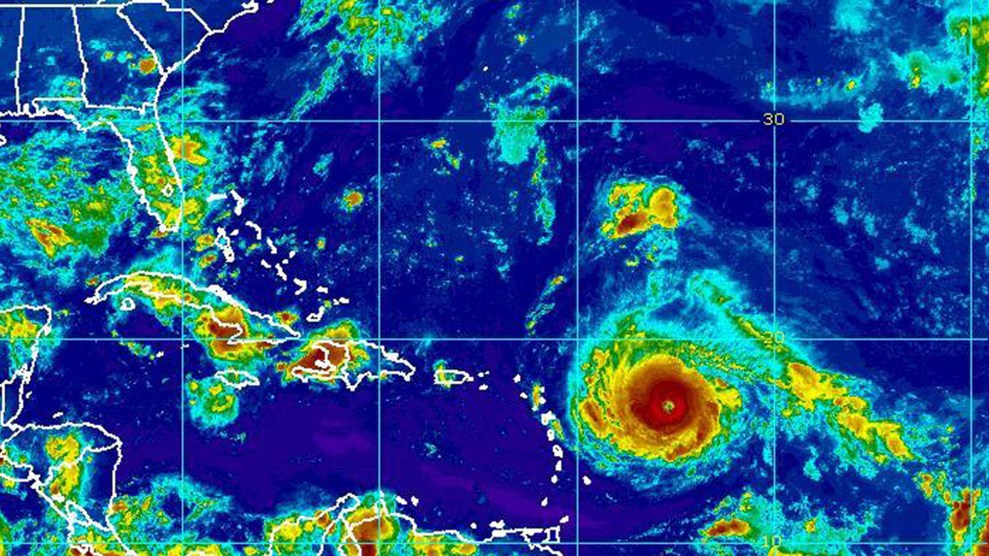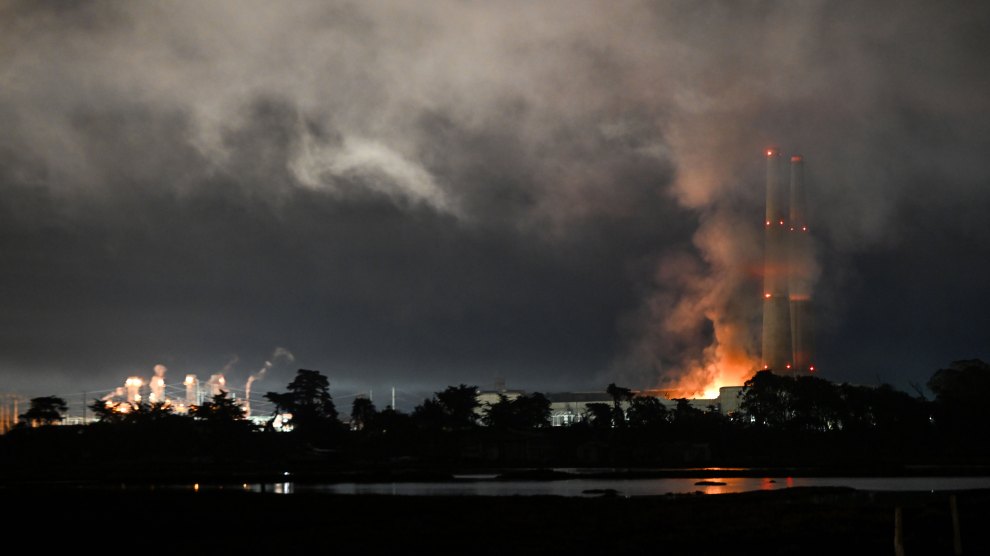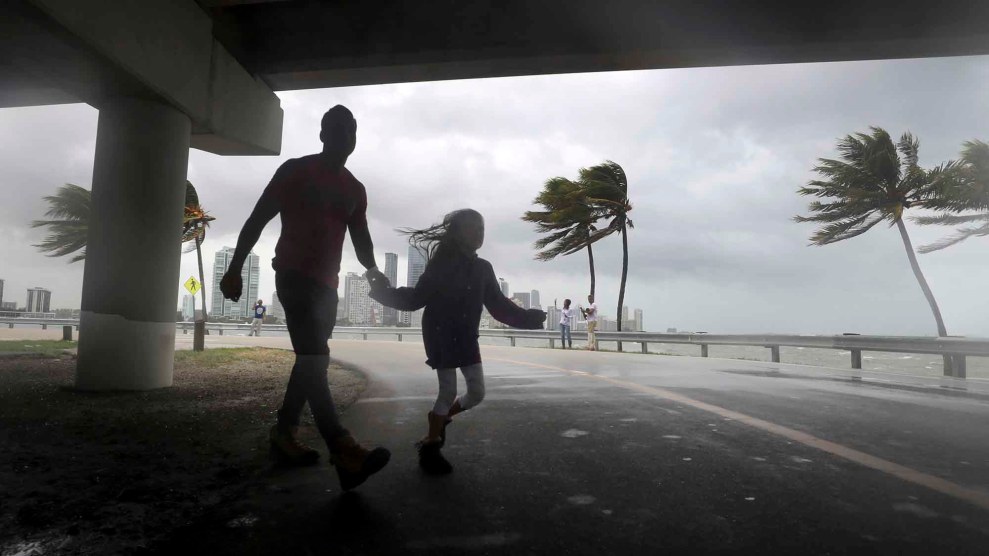
The winds and sea are whipped up off of the Rickenbacker Causeway as two people cross the street in Miami as Hurricane Irma approaches on Saturday, Sept. 9, 2017. Mike Stocker/South Florida Sun-Sentinel via AP
7:30 a.m. ET Irma has been downgraded to a Category 1 storm as it moves northeast towards Georgia’s coast this morning. Florida Gov. Rick Scott said nearly 6 million people were without power across the state. The National Hurricane Center is warning that the situation in Florida remains life-threatening.
Downtown #FortMyers never saw the eye….continuous eye wall for over an hour with the worst conditions possible. #spann #irma #frommyhome pic.twitter.com/AKnuRJDIaZ
— Zach Maloch ☈ (@ZachMalochWX) September 11, 2017
10:40 p.m. ET
That’s all for us tonight. We’ll be back with more updates in the morning. Until then, stay safe.
10 PM EDT Update Graphic on Hurricane #IRMA. pic.twitter.com/yGAYP8ppLh
— NWS Tampa Bay (@NWSTampaBay) September 11, 2017
7:00 p.m. ET
Some images of the damage in Naples and on Marco Island, where Irma made its second landfall Sunday afternoon.
JUST IN: Wind gust of 135 mph reported at Naples Airport, highest wind gust reported in Florida from #Irma so far https://t.co/5Kz3EN1ESV pic.twitter.com/MKRvMn06wQ
— ABC News (@ABC) September 10, 2017
Photos of the damage from #Irma in East Naples FL where my family lives. Taken by our neighbor Nick Tran. Everyone is safe. pic.twitter.com/Chaq1EiVLV
— Alex Moe (@AlexNBCNews) September 10, 2017
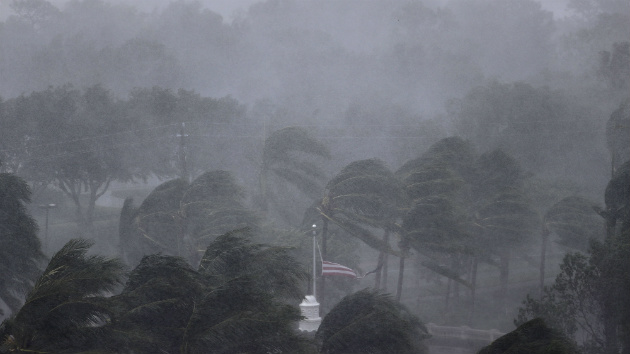
An American flag is torn as Hurricane Irma passes through Naples, Fla., on Sunday.
David Goldman / AP
https://twitter.com/MarcoIslandPD/status/907003821490089984
— Marco Island PD (@MarcoIslandPD) September 10, 2017
6:45 p.m. ET
As Irma, now a category-2 story, heads for Fort Myers and Tampa, CNN is reporting that 2.3 million customers in Florida are now without power. Sunset in Tampa is less than an hour away, which means that many residents of northern Florida will have to weather the hurricane’s winds, rain, and storm surge in the dark. Even the Florida Keys are still in danger.
#Irma will bring life-threatening wind and storm surge to the FL Keys and much of central and western FL tonight and Monday pic.twitter.com/OglCcC3OEL
— National Hurricane Center (@NHC_Atlantic) September 10, 2017
4:25 p.m. ET
The worst of the storm is now bearing down on the Gulf Coast Florida city of Naples, where a monster storm surge and intense winds are expected to wreak havoc. Wind gusts up to 131 miles per hour have been reported.
4:10 PM: Sustained wind of 87 mph with gust to 131 mph at Naples Municipal Airport. #Irma
— NWS Miami (@NWSMiami) September 10, 2017
Meanwhile, the National Weather Service is warning of “catastrophic” flash floods in the area from an “imminent” storm surge.
**Flash Flood Emergency* Naples, Marco Island, Chokoloskee, Everglades City until 6 PM. Catastrophic surge imminent. https://t.co/kfHH6KMdkr
— NWS Miami (@NWSMiami) September 10, 2017
Across the peninsula on the Atlantic Coast, tornado warnings are in effect.
Tornado Warning continues for Boca Raton FL, Boynton Beach FL, Delray Beach FL until 4:30 PM EDT pic.twitter.com/XWWbJYB2pS
— NWS Miami (@NWSMiami) September 10, 2017
3:55 p.m. ET
It’s not just the storm surge wreaking havoc in Miami. The high winds are also battering structures and ripping roofs off of buildings.
Using satellite before pictures @CityofMiamiFire was able to confirm a roof peeled off a two story apt Bldg at 2642 NE 5th Ave in #Miami pic.twitter.com/erTEpIFGTF
— City of Miami (@CityofMiami) September 10, 2017
https://twitter.com/HurricaneAlive/status/906961966719229954
Elsewhere in Miami, a second crane has collapsed.
Able to physically confirm second crane collapse at 600 NE 30th ter. @CityofMiami pic.twitter.com/Gz1CgSZsNe
— Mayor Francis Suarez (@FrancisSuarez) September 10, 2017
3:35 p.m. ET
In downtown Miami, the flooding continues. This is the view from a building where Univision employees are riding out the storm.
From my brother's Univision colleagues in downtown Miami pic.twitter.com/ADJlO5R6tR
— Paul Adams (@BBCPaulAdams) September 10, 2017
2:35 p.m. ET
The National Hurricane Center has issued an urgent warning for the southwest coast of Florida. As the eye passes over the region, the water is expected to rise rapidly. In the Naples and Marco Island areas, the storm surge will be between 10 to 15 feet.
Urgent warning about the rapid rise of water on the SW FL coast with the passage of #Irma's eye. MOVE AWAY FROM THE WATER! @NWSMiami pic.twitter.com/tjPidwn8D8
— National Hurricane Center (@NHC_Atlantic) September 10, 2017
Because of Hurricane Irma’s last-minute westward shift, many residents in southwest Florida did not evacuate. On Saturday, city officials were scrambling to open up shelters.
2:15 p.m. ET
Hurricane Irma’s track shifted west before making landfall, sparing Miami of the worst-case scenario. However, forecasters warned that even though the low-lying city wasn’t taking a direct hit, the storm could still produce extreme winds and damaging storm surge. And it looks like those predictions are coming true. As the storm ripped through the city, storm surge caused significant flooding in Brickell, the financial district in Downtown Miami.
WOW! Look at these pictures of Brickell Ave. in downtown Miami. INSANE! Please be safe. #HurricaneIrma #Miami #Soflo @nbc6 pic.twitter.com/0kymVvLXnZ
— Erika Glover 🎤 (@ErikaJGlover) September 10, 2017
This is Brickell in downtown Miami. Totally underwater. #HurrcaneIrma @wsvn w pic.twitter.com/Fc0GsBP1T5
— Brian Entin (@BrianEntin) September 10, 2017
Water still rising in downtown Miami along Brickell Avenue. Storm surge is intense. Neck deep in areas. @wsvn #HurrcaneIrma pic.twitter.com/RLhVWIkTzQ
— Brian Entin (@BrianEntin) September 10, 2017
“You’ve got whitecaps on Brickell. I don’t know what more to say”: Major #Irma flooding in Miami neighborhood https://t.co/HaKTS9DwgG pic.twitter.com/nAmXRXtqoq
— CNN Breaking News (@cnnbrk) September 10, 2017
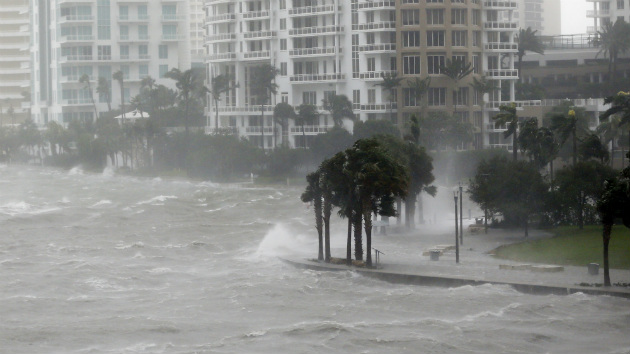
Waves crash over a seawall at the mouth of the Miami River from Biscayne Bay on Sunday in Miami.
Wilfredo Lee / AP
1:00 p.m. ET
Tampa’s mayor Bob Buckhorn just issued this dire warning on CNN, as his city braces for Irma’s impact: “We are about to get our own version of what hell looks like.”
“We are about to get punched in the face by this storm,” Buckhorn said earlier on Twitter.
We are about to get punched in the face by this storm. We need to be prepared.
— Bob Buckhorn (@BobBuckhorn) September 10, 2017
Florida’s third most populated city is in Irma’s sights as the storm tears up the state’s west coast as a Category 4 hurricane. The mayor has issued a mandatory curfew for the city from 6 p.m. Sunday, ahead of Irma’s anticipated impact around midnight.
Irma is projected to be moving up the Gulf Coast of Florida at 9 mph. The mayor of Tampa has announced a curfew in effect at 6:00 pm tonight pic.twitter.com/WsWnxZsQG7
— CBS News (@CBSNews) September 10, 2017
12:45 p.m. ET
At the Busch Gardens theme park in Tampa Bay, employees are ushering the animals to safety.
SINGLE FILE, EVERYONE! Flamingos being ushered to safety at @BuschGardens, along with other animals Stay safe, everyone! #HurricaneIrma pic.twitter.com/d7ozWBndKH
— FOX 13 Tampa Bay (@FOX13News) September 10, 2017
The park, which closed Friday afternoon, expects to remain closed through Tuesday. Other theme parks including SeaWorld Orlando, Universal Orlando, and Walt Disney World also closed down ahead of the storm.
12:25 p.m. ET
The National Hurricane Center reported at noon that Irma is beginning to leave the Florida Keys and is now approaching the state’s southwest coast, where officials are expecting major flooding triggered by storm surges. In parts of Southwest Florida, including Naples and Fort Myers, the NHC is warning the storm surge could exceed 9 feet. In a press conference Sunday, Florida Gov. Rick Scott (R) reminded residents that after the strongest winds pass, “the storm surge will rush in and can kill you.” He asked residents not to go outside until local officials say it is safe to do so.
Check out this @NHC_Atlantic map, showing that parts of SW Florida, including Fort Myers, could get hit with more than 9 feet of storm surge pic.twitter.com/37DqCixt2u
— Climate Desk (@ClimateDesk) September 10, 2017
Over on Florida’s Atlantic Coast, Miami is getting hit by flooding, too.
Brickell area in #Miami taking the surge from #Irma. It's as deep as 2' at SE 12th St. & Brickell Ave. pic.twitter.com/UAhcDLij6N
— Mike Seidel (@mikeseidel) September 10, 2017
11:10 a.m. ET
A construction crane has collapsed onto a building in downtown Miami. There are currently 20 to 25 cranes in the area which officials say were constructed to withstand winds up to 145 miles per hour. Daniel Alfonso, the city manager, said there wasn’t enough time to dismantle all the cranes before the storm him.
#BREAKING Construction crane collapses onto building in downtown Miami https://t.co/m2VteCqTPM pic.twitter.com/HwIdNEtifw
— WPLG Local 10 News (@WPLGLocal10) September 10, 2017
10:45 a.m. ET
Things are looking scary for Tampa and Tallahassee:
Latest track does not look good for Tallahassee. Hurricane force winds are expected. Falling trees are going to be dangerous! pic.twitter.com/6Qb1gS5JTG
— NWS Tallahassee (@NWSTallahassee) September 10, 2017
Tallahassee maximum wind gusts — 90 mph
Hurricane #Irma
After Hermine last year, this is not optimal. pic.twitter.com/8q9d0d43nB— Ryan Maue (@RyanMaue) September 10, 2017
10:20 a.m. ET, Sunday:
As category-4 Hurricane Irma pummels South Florida, one million people are already without power, according to NBC News. Meteorologists are now predicting that the eye of the storm will travel all the way up the state’s Gulf coast before hitting Tallahassee overnight.
Hurricane Irma at 8 a.m.: Category 4 storm batters Florida Keys https://t.co/ROQl1H8MLr pic.twitter.com/osBcIaWwb2
— Orlando Sentinel (@orlandosentinel) September 10, 2017
There’s still a chance that Irma could make a direct hit on Tampa, a city that is especially vulnerable to hurricanes, as Rebecca Leber reported in New Republic in 2015:
Tampa hasn’t been directly hit by a strong hurricane since the 1920s, though there have been a number of near-misses. Six died from the 1921 hurricane, when the population was a fraction of the four million people living in the surrounding area today. [MIT hurricane scientist Kerry] Emanuel cited western Florida and the northeast coast as parts of the country that “by sheer luck haven’t had storms in a long time.” These cities remain as vulnerable as ever. “The risk is probably in the next 50 years or so there will be a major hurricane in the region,” Emanuel said.
Tampa also recently topped the list of a report from RMS, a company that quantifies risk for insurers, for having the greatest risk of major economic losses from a 100-year storm (1 in 80 odds in a given year) higher than the risk in Miami (1 in 125), New York (1 in 200), and New Orleans (1 in 440).
But Irma is so large that life-threatening 80-mile-per-hour wind gusts are battering Miami on the other side of the state.
? Our officers are now sheltered for their safety. We cannot respond to calls for service. Stay indoors, DO NOT venture out! #HurricaneIrma pic.twitter.com/rHIjNzYyan
— Miami-Dade Police (@MiamiDadePD) September 10, 2017
10:00 p.m. ET: This will be the final update for Saturday, but Sunday we will provide continued Irma coverage. Heavy storms with what appear to be tornadoes are sweeping through southern Florida. The National Hurricane Center reports serious winds have started already in the Florida Keys, the string of low-lying islands that forecasters expect will bear the brunt of the storm.
The 9pm Update on #Irma – Wind gusts to near hurricane force reported in the Florida Keys – https://t.co/xizSZd5GX9
— NHC Atlantic Ops (@NHC_Atlantic) September 10, 2017
9:08 p.m. ET: As the storm began to batter the state, President Trump urged residents of Florida to pay attention to their governor.
Heed the advice of @FLGovScott!
“If you’re in an evacuation zone, you need to get to a shelter…there’s not many hours left.” Gov. Scott pic.twitter.com/92W8ViNMUK
— Donald J. Trump (@realDonaldTrump) September 10, 2017
8:40 p.m. ET: A number of Florida hospitals have either closed or evacuated their patients before Irma makes landfall. Here is a list from StatNews.
#IrmaHurricane2017 forces at least 30 hospitals to evacuate patients. A rundown by @MaxBlau https://t.co/GlOV56ORno
— Jeff DelViscio (@Jeffdelviscio) September 9, 2017
Among the casualties in the Virgin Islands are forests.
Absolute devastation in the US Virgin Islands after #Irma. Forests wiped out as far as the eye can see pic.twitter.com/z8a30nbRMM
— Brian L Kahn (@blkahn) September 10, 2017
7:40 p.m. ET: Two islands appear to have been spared the devastation of Hurricane Jose, but both had already been hammered by Irma.
On a positive note on an otherwise grim evening in the hurricane world, #Jose‘s strongest winds have spared Antigua and Barbuda. pic.twitter.com/ed5l12jYfw
— Philip Klotzbach (@philklotzbach) September 9, 2017
7:30 p.m. ET: In the eastern Caribbean islands, The Guardian reports Hurricane Jose “has weakened slightly, but remains a ‘dangerous category four hurricane’ as it heads towards the eastern Caribbean islands ravaged by Hurricane Irma.”
Meanwhile… Hurricane Jose is right on Irma’s tail. https://t.co/QxbzVvlH1G via @guardian pic.twitter.com/370QtidXEy
— Climate Desk (@ClimateDesk) September 9, 2017
7:15 p.m. ET: As Irma approaches Florida, it’s worth remembering what lays in its path. After Harvey, the EPA faced criticism it was slow to respond to Houston’s flooded Superfund sites, but the agency says it is prepared for Irma.
There are 2 Florida nuclear reactors taking a direct hit from Irma https://t.co/rxd5sJ57tj
— Climate Desk (@ClimateDesk) September 9, 2017
7:00 p.m ET: Winds and rain in Miami are intensifying. Everyone is urged to seek shelter.
Powerful wind and rain blowing into Miami right now. #hurricaneIrma @NBC6 pic.twitter.com/6CKPPeK811
— Michael Spears NBC6 (@MikeSpearsNBC6) September 9, 2017
Even while millions evacuate Florida, some remain behind. Here is a fascinating report from one scientist who is staying to study this historic storm.
Amazing post from a @NWSKeyWest scientist who is staying behind during Irma — to help save lives: https://t.co/Bm0wKFqji9
— Elizabeth Bruenig (@ebruenig) September 9, 2017
5:15 p.m. ET: Irma moved away from Cuba towards Florida, and there are, as yet, no confirmed reports of injuries or death, despite the massive storm damage.
Scenes of devastation in Caibarien, in northern #cuba, after passing of #hurricane #irma pic.twitter.com/i3r2ZHuVog
— Sarah Marsh (@reuterssarah) September 9, 2017
4:30 p.m. ET: According to ABC News’ meteorologists, Tampa and Sarasota might see storm surges of 10 feet and up to 15 feet from Fort Myers to Naples. Miami is expected see storm surges between 3 to 6 feet. Here is an updated storm trajectory for Florida on Sunday afternoon.
Devastating scenarios: GFS & Euro model show #Irma landfall in vicinity Naples & Ft. Myers Sunday PM: https://t.co/Tr56Uxt5TO pic.twitter.com/eCXNZB2YOy
— Capital Weather Gang (@capitalweather) September 9, 2017
4:10 p.m. ET: Hurricane Irma remains a Category 3 storm as it lingers over the northern coast of Cuba. But forecasters predict that it may become stronger as it approaches the Florida Keys early Sunday morning.
⚡️ “Irma expected to strengthen as it moves north towards Florida” by @NWShttps://t.co/u22bT6NOwH
— NWS (@NWS) September 9, 2017
Saturday morning, Florida Governor Rick Scott appeared in Sarasota, urging residents to escape deadly Hurricane Irma, now a Category 3, in the remaining hours before the storm makes landfall early Sunday morning.
“If you have been ordered to be evacuated, leave now. Not tonight, right now. Once the storm hits, remember law enforcement can’t save you,” he said. “We will do everything we can, but we can’t do it once the storm starts.”
Irma was still a Category 5 storm when it tore into Cuba’s northern coast late Friday night. The 160 mile an hour winds were so strong they destroyed the meteorological equipment used to record wind speeds, and left uprooted trees, dangerous storm surges, and flooding in its wake. This was after Irma tore through Puerto Rico and St. Martin, Haiti, and other Caribbean islands. Now it is headed towards the southern coast of Florida, where evacuations have been taking place for several days and new evacuations have just been ordered.
BREAKING: Florida asks another 700,000 to leave ahead of Hurricane Irma; nearly 7 million total urged to evacuate multiple states.
— The Associated Press (@AP) September 9, 2017
Winds and rain have already begun in Miami.
As Rebecca Leber reported in Mother Jones, “Florida’s vulnerability to a catastrophic storm has been obvious for years. Poor development planning, storm amnesia, a faulty insurance system, and a strong dose of climate-change denial have made coastal Florida, especially Miami and Tampa, much more vulnerable to Irma.”
The high winds and torrential rains pose a great threat, but even more dangerous are storm surges. Governor Scott warned resident the surges of twelve feet “could cover your house.”
A track just 5-10 miles west of this would be the worst-case U.S. coastal flood. Tampa could get 30ft of surge.https://t.co/CviaibyQwm https://t.co/1ivDzo0YlU
— Eric Holthaus (@EricHolthaus) September 9, 2017
The Guardian reports, “More than 50,000 people have gone to about 300 shelters around Florida, state emergency management officials have said, from about 5.6 million people told to leave their homes in coastal stretches.”
As residents seek shelter or have evacuated, confusing rumors have circulated. Some about gas stations running out of fuel are true, but others, Newsweek reports “that all hotels are obliged to accommodate pets and other animals belonging to those fleeing the storm is false, however emergency shelters are obliged to accommodate pets.” FEMA has issued a fact sheet in an effort to keep residents informed.
We created an #Irma rumor control page to help you verify what’s true and what’s not. Visit it here: https://t.co/nnXuF8Q7E8 pic.twitter.com/ypNwNRlOM0
— FEMA (@fema) September 8, 2017
President Trump tweeted this morning.
FLORIDA-
Visit https://t.co/pdBaD9t8SK to find shelters, road closures, & evacuation routes. Helpful Twitter list: https://t.co/BUMVlxGFe8 pic.twitter.com/ncnuqCeB5K— Donald J. Trump (@realDonaldTrump) September 9, 2017
HuffPost reported this morning that Trump’s Palm Beach estate, Mar-a-Lago, which is located in the storm’s path, has flood insurance through the National Flood Insurance Program administered through FEMA.
Scooplet–> Mar-a-Lago has a flood insurance policy through the federal government, FEMA told me https://t.co/BEgEuFabTy
— Dana Liebelson (@dliebelson) September 9, 2017
We will be providing updates throughout the weekend on the progress of the storm.
